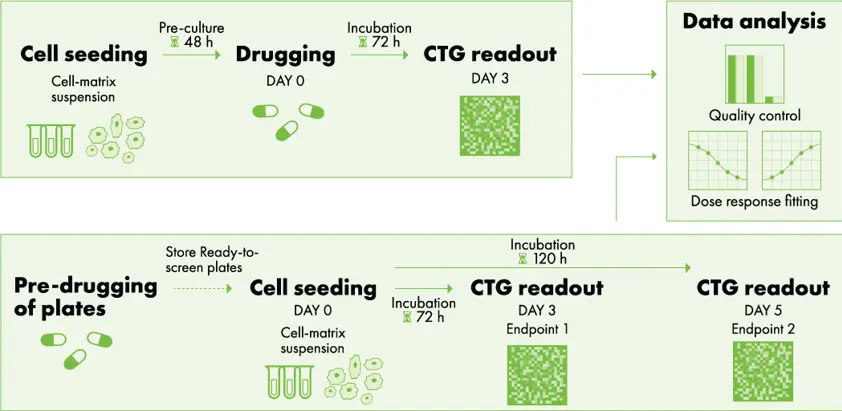Feodoroff, M., P. Mikkonen, L. Turunen, A. Hassinen, L. Paasonen, L. Paavolainen, S. Potdar, A. Murumägi, O. Kallioniemi and V. Pietiäinen (2023).
Abstract
"Central to the success of functional precision medicine of solid tumors is to perform drug testing of patient-derived cancer cells (PDCs) in tumor-mimicking ex vivo conditions. While high throughput (HT) drug screening methods have been well-established for cells cultured in two-dimensional (2D) format, this approach may have limited value in predicting clinical responses. Here, we describe the results of the optimization of drug sensitivity and resistance testing (DSRT) in three-dimensional (3D) growth supporting matrices in a HT mode (3D-DSRT) using the hepatocyte cell line (HepG2) as an example. Supporting matrices included widely used animal-derived Matrigel and cellulose-based hydrogel, GrowDex, which has earlier been shown to support 3D growth of cell lines and stem cells. Further, the sensitivity of ovarian cancer PDCs, from two patients included in the functional precision medicine study, was tested for 52 drugs in 5 different concentrations using 3D-DSRT.
Shortly, in the optimized protocol, the PDCs are embedded with matrices and seeded to 384-well plates to allow the formation of the spheroids prior to the addition of drugs in nanoliter volumes with acoustic dispenser. The sensitivity of spheroids to drug treatments is measured with cell viability readout (here, 72 h after addition of drugs). The quality control and data analysis are performed with openly available Breeze software. We show the usability of both matrices in established 3D-DSRT, and report 2D vs 3D growth condition dependent differences in sensitivities of ovarian cancer PDCs to MEK-inhibitors and cytotoxic drugs. This study provides a proof-of-concept for robust and fast screening of drug sensitivities of PDCs in 3D-DSRT, which is important not only for drug discovery but also for personalized ex vivo drug testing in functional precision medicine studies. These findings suggest that comparing results of 2D- and 3D-DSRT is essential for understanding drug mechanisms and for selecting the most effective treatment for the patient."
Feodoroff, M., P. Mikkonen, L. Turunen, A. Hassinen, L. Paasonen, L. Paavolainen, S. Potdar, A. Murumägi, O. Kallioniemi and V. Pietiäinen (2023). "Comparison of two supporting matrices for patient-derived cancer cells in 3D drug sensitivity and resistance testing assay (3D-DSRT)." SLAS Discovery.
